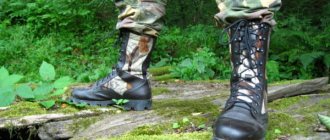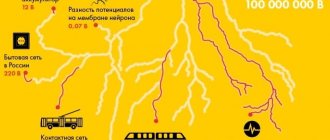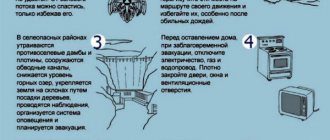How to survive a hurricane? Hurricane reports
Typically, regions potentially exposed to these elements have an established public warning system, so if you live in such an area, then when you receive an alarm signal you need to:
– strengthen the roofs of the building, stove and ventilation pipes;
– seal the windows in the attic (shutters, panels made of boards or plywood);
– clear balconies and courtyard areas from fire hazards;
– collect food and water for 2-3 days in case of evacuation, and also take documents, the most necessary things (flashlight, candles, clothes, knife, rope);
– move from light buildings to more durable buildings or civil defense structures;
Signs of an approaching hurricane
The signs indicating the approach of a tornado or hurricane are approximately the same, and you also need to act according to the general scheme to save yourself.
If meteorological services have not warned the population about an impending hurricane, or you are far from civilization without communication with the outside world, you should know the main signs of impending danger:
– increased wind speed;
– a sharp drop in atmospheric pressure;
– heavy rains, storm surge;
– rapid precipitation;
- a cluster of thunderclouds of dark blue, almost black color.
Lesson 14 Rules for safe behavior in the event of a threat and during hurricanes, storms and tornadoes
Measures to reduce damage from hurricanes, storms, tornadoes
Of great importance for reducing losses from hurricanes, storms and tornadoes is timely forecasting and warning the population of their approach.
From time immemorial, people have dreamed of learning how to predict the occurrence of hurricanes. The sailors were especially attentive. They determined this moment by the type of clouds, sunset, drop in pressure, air condition and temperature. But these are local signs.
Forecasters are closely monitoring the state of the atmosphere these days. Their most reliable and vigilant assistants are radars and artificial earth satellites. In one revolution around the planet, a weather satellite is able to “inspect” more than 8% of its surface, and in a day - the entire planet.
Accurate forecasting of the occurrence of natural disasters allows government authorities to take timely preventive measures in the immediate threat of hurricanes, storms and tornadoes.
Particular attention is paid to preventing those destructions that can lead to the emergence of secondary factors of damage (fires, accidents in hazardous industries, dam breaks, etc.) exceeding the severity of the impact of the natural disaster itself. Measures are taken to prevent spills of hazardous liquids.
An important area of work to reduce damage is the struggle for the stability of communication lines, power supply networks, wired urban and intercity transport, which are vulnerable to hurricanes, storms and tornadoes.
When carrying out operational measures in rural areas, along with generally accepted measures, they organize the delivery of feed to farms and complexes, the pumping of water into towers and additional containers, and the preparation of backup sources of energy supply. Farm animals located in forest areas are taken out into the open or sheltered in ground structures and natural shelters.
When you receive a message about an approaching hurricane, close doors, windows, and attic hatches. Secure items located in yards or take them indoors
To effectively protect the population from hurricanes, storms and tornadoes, preparations are being made for the use of shelters, basements and other buried structures.
Information about the threat of hurricanes, storms and tornadoes is provided in advance.
What to do during a hurricane. Hurricane protection
How to behave if a hurricane catches you in nature, while traveling or hiking?
First of all, you should visually identify a potential threat. The stronger the gusts of wind, the precipitation, the darker the horizon, the more quickly you should act. If it is possible to get to serious shelters, this is a house, a basement, then immediately head there. Even if your expectations from the approaching mass of clouds do not come true and everything is limited to heavy rain and a couple of lightning bolts, it is better to play it safe. If circumstances call for you to meet the hurricane face to face, you need to:
– find as open an area as possible. Stay away from trees, rivers, lakes, reservoirs, the sea;
- the best place to hide from a hurricane is at the bottom of a ditch, hole, ditch, narrow ravine, gorge, you can even climb into a den, of course, provided that it is free, although I would not risk that, meeting a bear in most cases is more dangerous than a hurricane. In general, you need to position your body as low as possible to increase your chance of survival during a hurricane.
– cover your head with clothes, tree branches;
– it is not recommended to be inside a car or other vehicle (only a tank will be safe), get out and follow the instructions above;
How to behave during a hurricane or tornado in a building?
If the threat of a hurricane overtakes you in a building or you have the opportunity to quickly take shelter in it, you should:
This is interesting: Survival priorities
– move away from the windows, take a safe place near the walls of the interior, in the hallway, near built-in closets, in bathrooms, toilets, closets, closets; if there is, go down to the basement.
– extinguish the fire, turn off the electricity, gas;
– turn on the portable radio and mobile phone to receive information from the civil defense headquarters;
– follow the instructions given to you over the radio. If there is none, wait until the weather stabilizes and the threat of a hurricane has passed;
What to do outside during a hurricane?
When disaster strikes you in the middle of a city street, you should stay as far as possible from light buildings, buildings, bridges, overpasses, power lines, trees, rivers, lakes, and industrial facilities. Move further away from shopping centers and “glass” buildings. The ideal option is to go to the metro or underground parking; you can also hide in the basement of a store.
Actions of the population under the threat of a hurricane
If there is time (algorithm of actions):
- Share the information received with family members, acquaintances and neighbors;
- Check the location of children. For safety they must go into the house;
- Bring garden furniture, building materials or decorative items that are light in weight home;
- Make additional reinforcements for windows, doors, hatches, ventilation holes;
- Protect your home from possible fragments when windows break. To do this, curtain them or close them with blinds;
- Take a flashlight, matches, spare batteries, as well as a minimum set of tools with you to the shelter;
- Turn off the gas valves, disconnect all appliances from the power supply, extinguish the fire in the fireplace or stove;
- Take warm clothes, a supply of non-perishable food and water;
- Regularly inspect the trees on your property. Cut down rotten, “sick” and dried out ones. They will be dangerous in strong winds.
ABOUT THIS THEME
Civil Defense Alert Signals
Dealing with a hurricane also includes finding safe, secure shelter. A wooden house can be destroyed by the speed and force of a hurricane wind, so it is better to wait it out in the cellar or basement.
You can also hide in secure storage rooms, under the table, in durable built-in cabinets. If there are shelters in your locality for such cases, then you should go there.
The radio must be with you. When the wind subsides, do not rush to leave the shelter; it is better to wait for an official notification from the Ministry of Emergency Situations.
If you are overwhelmed, then sound signals.
It is better if your neighbors have information about the location of your cellar or basement.
In the city and in open areas
What to do during a hurricane
If you find yourself in the zone of action of a raging element while on the street, then take shelter in the entrance or underground passage. Stay away from storefronts, store signs, road signs, billboards, bridges and trees. These are all unreliable shelters, which themselves can pose a great danger if damaged and collapsed. Do not go close to exposed or downed power lines.
When there is a squally wind, a lot of dust forms in the air, so protect your respiratory organs with a damp handkerchief or napkin; there is also a risk of eye damage. If you have glasses, wear them. If you do not see a place in your immediate surroundings where you can hide, then use any boxes or sheets of plywood to protect yourself from flying glass and debris.
ABOUT THIS THEME
Types of shelters and shelters
In open areas, try to find a hole, ditch, ravine or lowland. Lie down in it, pressing tightly to the ground, protect your head with your hands or clothes. A car is not a reliable shelter. It will be safer to get out of it and look for another place where you can wait out the hurricane winds.
The wrong thing to do during a hurricane is to enter destroyed or damaged buildings or houses. Often they cannot withstand the repeated intensification of the wind and collapse, burying everyone who is there under their rubble. If a hurricane is accompanied by rain and thunderstorms, then you should protect yourself from lightning.
To do this, avoid tall objects, do not use your phone, and get rid of all metal objects.
If you find yourself in a snowstorm in an open area, try to get to the roads and stick to them. The main roads are being cleared and there is a better chance of finding help there.
Countryside
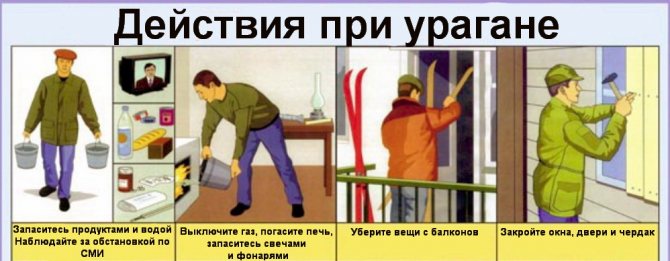
Actions during a hurricane
Most often, such wind phenomena occur in villages and towns where there is a lot of open space. There will definitely be an announcement on your radio or TV about an approaching hurricane, so if weather conditions worsen, turn them on and listen to information from emergency services.
After the disaster, they begin to inspect the destruction and restore and rescue work. You can use electrical appliances, gas installations and panels again only after carefully checking them for possible damage. Before entering the house, make sure that the load-bearing walls are not seriously damaged.
If necessary, make temporary reinforcement of the ceiling. Don't risk drinking tap water, even if you're very thirsty. It must first be boiled or disinfected with special tablets, and then allowed to sit for half an hour. Provide all possible assistance in saving people and animals.
How to behave during a tornado
To find out how to behave during a tornado (Figure 1), you should know its main signs:
- A sharp decrease in atmospheric pressure;
- Increased wind speed - sharp gusts;
- Squally showers - an approaching thunderstorm front;
- Heavy snowfall and ground dust.
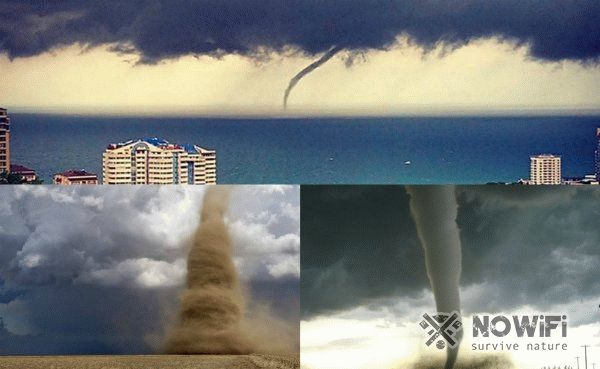
Figure 1. Tornado options
The population is notified in advance of the approach of a tornado or tornado:
- Department of Emergency Situations, Civil Defense and Ministry of Emergency Situations;
- Using special warning vehicles and electric sirens;
- Words serve as a signal - attention to everyone, threat of a tornado;
- Emergency messages for local residents to evacuate are in effect;
- Disaster announcements are broadcast on radio and television.
Actions of the population in the event of a tornado threat
A tornado is a natural phenomenon that occurs in a thundercloud, then forms a funnel with a diameter of tens and sometimes hundreds of meters and descends down to the ground.
The following natural phenomena may indicate the formation of an air funnel:
- Increased wind when stormy skies appear;
- A sharp decrease in atmospheric pressure, which causes nausea, lethargy, and headache in a person;
- Sudden heavy precipitation (rain, snow), raising ground dust;
- Strong hum.
A tornado is not always accompanied by worsening weather; sometimes this phenomenon occurs against the backdrop of a sunny and cloudless sky.
Modern meteorological equipment is capable of identifying a natural phenomenon in advance, therefore the population is warned about the approach of a tornado with the help of the media, as well as with the use of civil defense warning systems.
The sound of electric sirens is accompanied by verbal messages: “Attention everyone!”, “Tornado threat.” If a decision is made to evacuate, the alert transmits information about the locations of evacuation gathering points for the civilian population.
When you receive a warning
Having heard sound signals, you should take documents, the minimum necessary things and head to the evacuation site.
If time permits, it is recommended to do the following (algorithm):
- Close the windows. If possible, reinforce them with boards, plywood or shields;
- Remove flammable items from the balcony;
- If there is an adjacent territory, free it as much as possible from loose objects (benches, swings);
- Don't forget to reinforce the roof, attic and ventilation pipes;
- Create a supply of long-term food and drinking water for 2-3 days;
- Make sure you have autonomous lighting sources (lanterns, generators, candles). Pack a supply of batteries and matches in waterproof material;
- Tell family members and neighbors that a natural hazard is approaching.
If you hear a message about a tornado late and evacuation is impossible, then take care of your safety yourself.
In a buiding
If the elements find you in a building:
Choose interior spaces for shelter. The safest places are considered to be the bathroom, restroom, corridor, storerooms, and doorways. Built-in, durable cabinets and heavy tables secured to the floor can also serve as shelter. If you are in a wooden building, then it will be safer to go down to the basement.
Be sure to turn off power to all electrical items and turn off gas equipment. To receive information from civil defense authorities on emergency situations, use a radio.
On the street
If you encounter a tornado on the street of a populated area:
Try to stay away from light structures, trees, stands, signs, bridges and power lines. The most dangerous objects are those carried by a tornado that fall to the ground at high speed. For protection, use available means: a sheet of plywood, a box, boards.
Don't panic and look for a place where you can wait out the tornado. Do not try to hide in damaged buildings or industrial sites, as they may explode or be completely destroyed when the wind picks up again.
In a large populated area, look for metro stations or underground passages. They will become reliable protection from a tornado.
In open areas
If you are in an open area (field, plain, mountainous area):
Look for earthen depressions: ditches, ditches, road ditch, ravines. Lie down in it, pressing your face firmly to the ground. Be sure to cover your head with clothes and a bag. In a tornado situation, a car will not provide reliable protection. It's dangerous to stay there. Get out of it and protect yourself as described above.
When raising dust, protect your eyes and respiratory organs with any piece of cloth. You can pre-moisten it with water. Often a tornado is accompanied by heavy rain or hail, so try to protect your body from the natural elements as much as possible. Stay away from bodies of water, as a tornado is capable of sucking up large amounts of water and then suddenly releasing it in a single gulp with great speed.
What not to do during a storm warning
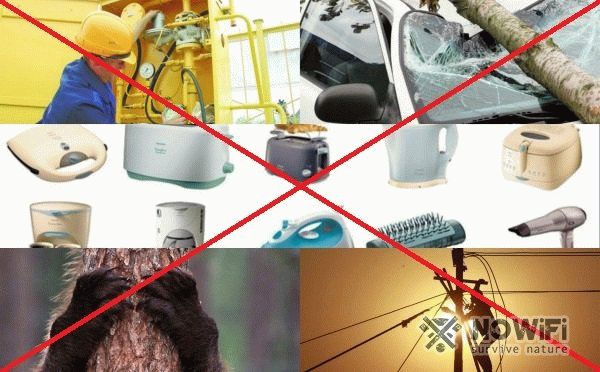
Figure 2. During a tornado, protect yourself by following a few important rules
During a storm it is strictly prohibited (Figure 2):
- Use electrical appliances and gas stoves in the house;
- Hide from bad weather behind trees, billboards, fences and dilapidated structures;
- Go inside flimsy structures and damaged buildings;
- Be near objects containing toxic and flammable substances, near power lines and poles;
- Touch central heating, gas supply and drainage pipes;
- Located on bridges and overpasses, any other elevations;
- Park vehicles under trees;
- Leave windows and doors of houses open, leave loose objects in the yard and on the balcony that can be easily caught by gusts of heavy wind.
How to make sure your loved ones are safe
As a rule, regions that are at risk of natural disasters have an established method of warning and action.

Figure 3. Safety measures during a tornado
When receiving an alarm, you should clearly know how to behave during a tornado or hurricane (Figure 3):
- Strengthen buildings - roofs, stoves and ventilation pipes of buildings, close windows with shutters or boards;
- Clear the yard area and space on the balconies from fire hazards and foreign objects;
- In case of evacuation, collect supplies of food and water for 2-3 days, take with you a first aid kit and documents, the necessary minimum - a flashlight, candles, a spare set of clothes, a radio with batteries, personal hygiene products, a phone with a charger, money;
- Move from light buildings to protective structures of civil defense, take safe places in permanent buildings;
- Don’t forget about your pets - you need to take them into the shelter with you;
- Contact loved ones and relatives, agree on a time for communication, warning them about the disaster.
This is interesting: How to get out of the forest if you get lost
What to do if you are indoors?
Here is a list of recommendations on how to behave during a tornado if you decide to wait it out in a building (Figure 4):
- Close ventilation openings, windows, vents and doors;
- Turn off all electrical appliances and turn off the gas;
- If there is a basement, take everything you need and hide in it;
- If there is no basement, take shelter in one of the interior rooms, a closet or bathroom, a doorway or corridor, do not go near the windows;
- If you have time to spare, clear out the balconies and strengthen the roof.
What to do if a hurricane catches you outside?
Do not approach isolated or unsafe buildings, beware of billboards, act according to the instructions:
- Find a hole, notch or depression in the ground (Figure 5), a ditch or ditch - lie down in it and protect your head with your hands or clothing;
- Stay away from gas stations, high-voltage lines, flammable objects and chemical plants;
- If possible, take shelter in an underground passage, at a metro station, or any strong building;
- If you find yourself in a car, leave the vehicle, leaving it near a wall in the direction of the wind to prevent it from overturning and hide in a road ditch or the nearest fortification.

Figure 5. If a hurricane finds you outside, your chances of survival are still very high
Actions of the population in the event of a storm threat
A storm is characterized by the occurrence of strong and prolonged winds, the speed of which can reach 100 km/h. When receiving a storm warning, it is recommended that you follow the same rules as when you receive a tornado warning.
While at home
How to protect yourself from the elements while at home:
- Close windows and entrance doors tightly. Don't forget the attic and basement;
- You can stick paper strips on the windows;
- Turn off the gas, completely de-energize the house;
- Stock up on food and water for several days;
- Be sure to take care of the availability of autonomous lanterns and candles;
- The first aid kit and all necessary medications must be in a safe, waterproof place;
- Try to stay away from windows and indoors during a storm;
- Leave only the radio on.
Do not leave the house until you hear from the Ministry of Emergency Situations a notification that the disaster has ended.
Being on the street
If you are outside during a storm:
If a storm warning finds you in an open space, try to quickly find a place where you can shelter from the storm. This could be the nearest solid building of a cafe, supermarket, or the entrance to a house. Do not go into kiosks or tents.
If you don’t see shelter, then ground depressions (pits, ditches) are used. Lie face down in them, and do not forget to protect your head with any available object.
Do not locate near billboards, banners, electrical outlets, or glass signs. Do not use metal objects as protection. During a storm, there are often lightning strikes.
You can ride out the elements in a car, but do not park under trees, next to poles or billboards.
What to do after a natural disaster
Do not leave the building without official permission from authorized authorities. A natural disaster can rage for a few minutes or a couple of hours. When going outside, do not go near exposed wires, go around damaged buildings and trees. It is recommended to use electrical appliances only after checking the electrical wiring by specialists. If your home is damaged, you should not enter it. Report this to the Ministry of Emergency Situations and wait for specialists to examine it.
What to do after?
Now let's figure out how to behave during a tornado, when its threat has passed:
- Do not touch downed power lines and do not use open fire, as well as electrical appliances until they are checked for serviceability;
- Avoid trees, swaying signs, banners and banners, damaged buildings (Figure 6), even if you live or work in them;
- Do not take any independent actions to eliminate the consequences of the storm until the emergency services personnel arrive;
- Beware of gas leaks and the possibility of electrical shock from lightning, as storms are usually accompanied by severe thunderstorms.
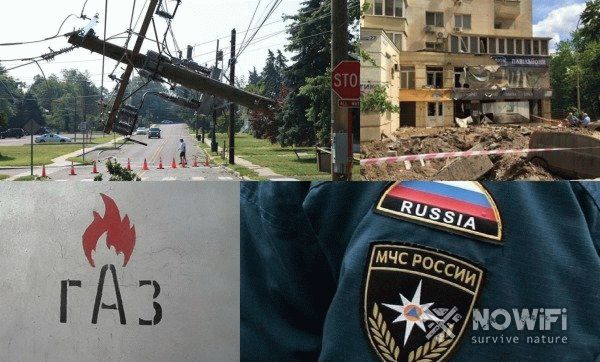
Figure 6: Even after the storm is over, stay safe and careful




